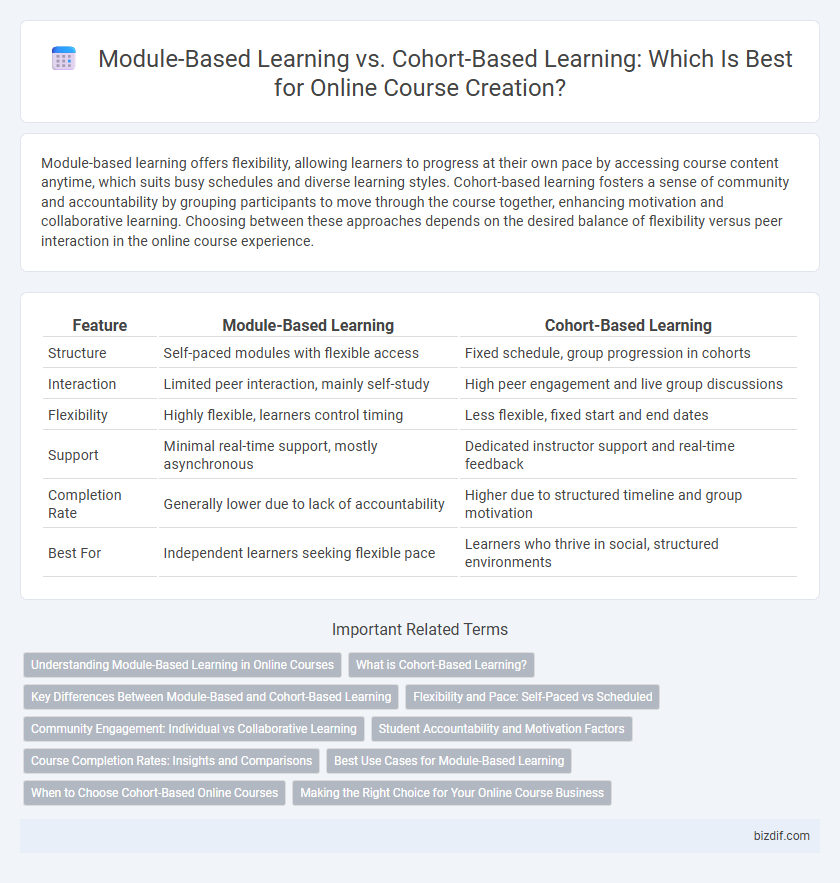Module-based learning offers flexibility, allowing learners to progress at their own pace by accessing course content anytime, which suits busy schedules and diverse learning styles. Cohort-based learning fosters a sense of community and accountability by grouping participants to move through the course together, enhancing motivation and collaborative learning. Choosing between these approaches depends on the desired balance of flexibility versus peer interaction in the online course experience.
Table of Comparison
| Feature | Module-Based Learning | Cohort-Based Learning |
|---|---|---|
| Structure | Self-paced modules with flexible access | Fixed schedule, group progression in cohorts |
| Interaction | Limited peer interaction, mainly self-study | High peer engagement and live group discussions |
| Flexibility | Highly flexible, learners control timing | Less flexible, fixed start and end dates |
| Support | Minimal real-time support, mostly asynchronous | Dedicated instructor support and real-time feedback |
| Completion Rate | Generally lower due to lack of accountability | Higher due to structured timeline and group motivation |
| Best For | Independent learners seeking flexible pace | Learners who thrive in social, structured environments |
Understanding Module-Based Learning in Online Courses
Module-based learning in online courses divides content into focused, manageable sections, allowing students to progress at their own pace while mastering specific skills within each module. This approach enhances knowledge retention by offering clear objectives, interactive activities, and assessments tailored to individual topics. Studies show that structured modules improve engagement and provide flexibility, making them ideal for diverse learning styles and busy schedules.
What is Cohort-Based Learning?
Cohort-based learning is a structured online course format where groups of learners progress through the material simultaneously, fostering collaboration and community engagement. This method enhances accountability and motivation by encouraging peer interaction and real-time feedback. Compared to module-based learning, cohort-based courses emphasize synchronous participation and collective progress, which can improve learner retention and outcomes.
Key Differences Between Module-Based and Cohort-Based Learning
Module-based learning offers flexibility with self-paced progress through segmented content, ideal for learners seeking autonomy and varied scheduling. Cohort-based learning emphasizes synchronized group engagement and peer interaction, fostering accountability and collaborative skill-building within a defined timeframe. Key differences lie in pacing control, social dynamics, and structured deadlines impacting learner motivation and retention.
Flexibility and Pace: Self-Paced vs Scheduled
Module-based learning offers flexibility through self-paced study, allowing learners to progress according to their individual schedules and learning speeds. Cohort-based learning follows a scheduled timeline, promoting real-time interaction and structured progress alongside peers. Choosing between these models depends on whether learners prioritize autonomous pacing or collaborative, time-bound engagement.
Community Engagement: Individual vs Collaborative Learning
Module-based learning emphasizes individual progress through self-paced study, allowing learners to focus deeply on specific topics. Cohort-based learning fosters collaborative engagement by encouraging interaction, discussion, and peer support within a structured timeline. The choice influences community dynamics, where module-based favors independence and cohort-based enhances collective motivation and accountability.
Student Accountability and Motivation Factors
Module-based learning empowers students with flexibility, allowing self-paced progress that enhances intrinsic motivation and personal accountability through clear, manageable tasks. Cohort-based learning fosters accountability via peer interaction and scheduled milestones, leveraging social motivation and collaborative engagement to maintain consistent participation. Understanding these dynamics helps educators design courses that optimize student commitment by balancing autonomy with structured community support.
Course Completion Rates: Insights and Comparisons
Module-based learning offers flexible pacing, leading to varied completion rates as learners progress independently, while cohort-based learning fosters accountability and engagement through scheduled sessions, often resulting in higher course completion rates. Research highlights that cohort-based courses can improve completion rates by up to 30% compared to self-paced modules due to peer interaction and structured timelines. Understanding these dynamics helps educators design courses that balance autonomy with social motivation to enhance learner success.
Best Use Cases for Module-Based Learning
Module-based learning excels in self-paced environments where learners require flexibility to progress independently, making it ideal for professionals balancing work and study. It suits complex subjects that benefit from segmented content, allowing learners to revisit specific modules for reinforcement. This approach also supports scalable course design, efficiently accommodating diverse learner needs without the constraints of fixed schedules.
When to Choose Cohort-Based Online Courses
Cohort-based online courses are ideal for learners seeking structured schedules and real-time interaction, fostering community and accountability. These courses enhance engagement through live discussions, group projects, and peer feedback, driving higher course completion rates. Organizations aiming for collaborative skill development and networking benefits should opt for cohort-based formats to maximize learner motivation and support.
Making the Right Choice for Your Online Course Business
Module-based learning offers flexibility, allowing students to progress at their own pace, making it ideal for diverse schedules and self-motivated learners. Cohort-based learning fosters community engagement and accountability through scheduled group interactions, which enhances motivation and completion rates. Choosing the right model depends on your target audience's preferences, course content complexity, and desired student outcomes for your online course business.
Module-based learning vs Cohort-based learning Infographic

 bizdif.com
bizdif.com